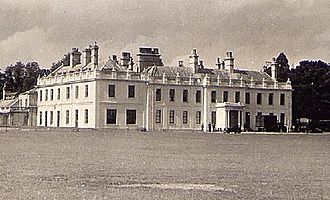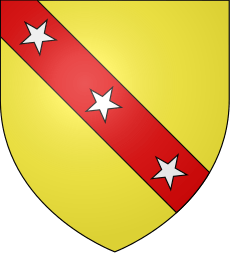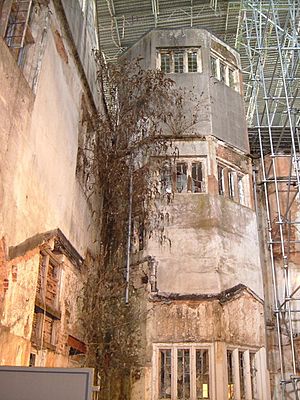Poltimore House facts for kids
Quick facts for kids Poltimore House |
|
|---|---|

Poltimore House c. 1930
|
|
| Alternative names | Bampfylde House |
| General information | |
| Status | under renovation |
| Type | Country house |
| Architectural style | Tudor |
| Town or city | Poltimore, Devon |
| Country | England |
| Coordinates | 50°45′29″N 3°27′54″W / 50.75794°N 3.46498°W |
| Construction started | 1550 |
| Renovated | begun 2005 |
| Owner | Poltimore House Trust |
|
Listed Building – Grade II
|
|
| Designated | 11 November 1952 |
| Reference no. | 1098310 |
Poltimore House is a large country house in Poltimore, Devon, England. It was once the home of the Bampfylde family for many centuries. This family became very important and were given the title Baron Poltimore in 1831.
The house still has parts of older buildings that the family built on the same spot. It is now a special historic building, known as a Grade II* listed building. For many years in the late 1900s, the house was in very poor condition. But in 2003, a group of volunteers started raising money to fix it up. They even made it to the finals of a TV show called Restoration, which helped them get attention for their project.
Contents
History of Poltimore House
How the Bampfylde Family Got Poltimore
The Bampfylde family received the land of Poltimore in 1298. It was given to them by William Pontyngton, a priest from Exeter Cathedral. We don't know exactly where the first family home was. However, it was likely in or near the village.
The Poltimore House you see today was started in 1550. It was built by a man named Richard Bampfylde. We don't know when the house was fully finished. But when Richard passed away in 1595, he left the house to his son, Amyas Bampfylde. Richard was an important person, serving as the Sheriff of Devon in 1576. This means his grand house was probably ready by then.
You can still see two parts of Richard's original house in the building today. It's unclear if his first house was just these two sections or if it had more wings. Later family members added to the house over the years. The last big building work happened in 1908.
Poltimore House After the Bampfyldes
The Bampfylde family lived in Poltimore House until 1920. After that, they decided to sell the house and its surrounding land. The land was sold, but the house itself was not.
Instead, Poltimore House was rented out. It became a girls' school called Poltimore College. This school operated until 1939. In 1940, during World War II, boys from Dover College moved into Poltimore House for safety.
In 1945, the house became a private hospital. When the National Health Service (NHS) started in 1948, they took over the hospital. Poltimore House continued as a hospital until it closed in 1974.
The House Falls Apart
After the hospital closed, the house had several different owners. Sadly, in 1987, there was a fire set on purpose. After that, the house was left empty. It suffered from people stealing things and causing damage. Because of this, Poltimore House fell into a very bad state.
Restoring Poltimore House
In 2000, a group called the Poltimore House Trust was created. Their goal was to find a new purpose for the house and bring it back to life. The first step was to protect the house from more damage. In 2005, they put up scaffolding and a special roof over the entire building.
In 2009, the Trust received a large sum of money, £500,000, from English Heritage. This money allowed them to finally begin the important restoration work.
Future Plans for Poltimore House
The Poltimore House Trust has big plans for the future. They want the house to become a busy and exciting place. Here are some of their ideas:
- A place for arts and creativity: It will be a space for artists, craftspeople, and people who work in media or software.
- Workspaces for creative people: There will be modern offices and studios for people to work.
- The Poltimore Forum: Important talks and workshops will happen here. Leading thinkers will visit to share their ideas.
- A meeting place: The house will have great meeting rooms for businesses and groups.
- Learning and new ideas: It will be a place to learn new skills and connect different fields like history, technology, and art.
- A fun day out: Visitors can come to Poltimore House for inspiration, learning, or just to relax and have fun.
These projects aim to make Poltimore House a valuable resource again. It will benefit local businesses, artists, and the whole community.
Visiting Poltimore House
The charity called Friends of Poltimore House helps people visit the house. You can check their website to find out when the house is open to the public.
Charities Helping with Restoration
- The Friends of Poltimore House, Poltimore House, Poltimore, Exeter, EX4 0AU email: chairman@poltimore.org.uk
- Poltimore House Trust, Poltimore House, Poltimore, Exeter, EX4 0AU email: secretary@poltimore.org





